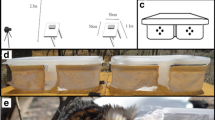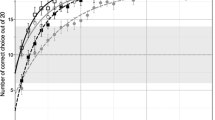Abstract
Place learning abilities represent adaptations that contribute also to foraging efficiency under given spatio-temporal conditions. We investigated if this ability in turn constrains decision making in two sympatric vole species: while the herbivorous common vole (Microtus arvalis) feeds on spatio-temporally predictable food resources (e.g. roots, tubers and shoots of plant tubers), the omnivorous bank vole (Myodes glareolus) additionally subsists on temporally unpredictable food resources (e.g. insects and seeds). Here, we compare the spatial reference memory and working memory of the two species. In an automated operant home cage with eight water places, female voles either had to learn the fixed position of non-depletable places (reference memory task) or learn and avoid previously visited water places depleted in a single visit (win-shift task). In the reference memory task, Microtus females required significantly more choices to find all water places, initially performed slightly worse than Myodes females, and displayed slightly lower asymptotic performance. Both species were highly similar in new learning of the same task. In the more complex win-shift task, asymptotic performance was significantly lower in Microtus (72% correct) than in Myodes (79%). Our results suggest that both vole species resemble each other in their efficiency to exploit habitats with low spatio-temporal complexity but may differ in their efficiency at exploiting habitats with temporally changing spatial food distributions. The results imply that spatial ability adjusted to specific food distributions may impair flexible use of habitats that differ in their food distribution and therefore, decrease a species’ chances of survival in highly dynamic environments.






Similar content being viewed by others
References
Amrein I, Lipp H-P (2009) Adult hippocampal neurogenesis of mammals: evolution and life history. Biol Lett 5:141–144
Amrein I, Slomianka L, Lipp H-P (2004) Granule cell number, cell death and cell proliferation in the dentate gyrus of wild-living rodents. Eur J Neurosci 20:3342–3350
Balda RP, Kamil AC (1998) The ecology and evolution of spatial memory in corvids of the southwestern USA. In: Animal cognition in nature, New York
Balmelli L, Nentwig W, Airoldi JW (1999) Food preferences of the common vole Microtus arvalis in the agricultural landscape with regard to nutritional components of plants. Z Säugetierkd 64:154–168
Boyce CK, Boyce JL (1988) Population biology of Microtus arvalis. III. Regulation of numbers and breeding dispersion of females. J Anim Ecol 57(3):737–757
Briner T, Nentwig W, Airoldi J-P (2005) Habitat quality of wildflower strips for common voles (Microtus arvalis) and its relevance for agriculture. Agric Ecosyst Environ 105:173–179
Buesching CD, Newman C, Twell R, McDonald DW (2007) Reasons for arboreality in wood mice Apodemus sylvaticus and Bank voles Myodes glareolus. Mamm Biol 73:318–324
Chapillon P, Roullet P, Lasalle JM (1995) Ontogeny of orientation and spatial learning on the radial maze in mice. Dev Psychobiol 28(8):429–442
Dobly A (2001) Movement patterns of male common voles (Microtus arvalis) in a network of Y junctions: role of distant visual cues and scent marks. Can J Zool 79:2228–2238
Dobly A, Rozenfeld FM (2000) Burrowing by common voles in various social environments. Behaviour 137:1443–1462
Dukas R (2004) Evolutionary biology of animal cognition. Annu Rev Ecol Evol Syst 35:347–374
Eccard JA, Ylönen H (2002) Direct interference or indirect exploitation? An experimental study of fitness costs of interspecific competition in voles. Oikos 99:580–590
Eccard JA, Ylönen H (2007) Costs of coexistence along a gradient of competitor densities: an experiment with arvicoline rodents. J Anim Ecol 76:65–71
Eichenbaum H, Cohen NJ (2001) From conditioning to conscious recollection. Memory systems of the brain. Oxford Psychology Series. Oxford University Press, Oxford
Galsworthy MJ, Amrein I, Kuptsov PA, Poletaeva II, Zinn P, Rau A, Vyssotski A, Lipp H-P (2005) A comparison of wild-caught wood mice and bank voles in the Intellicage: assessing exploration, daily activity patterns and place learning paradigms. Behav Brain Res 157:211–217
Gaulin SJC, Fitzgerald RW (1986) Sex differences in spatial ability: an evolutionary hypothesis and test. Am Nat 127(1):74–88
Gaulin SJC, Fitzgerald RW (1988) Home-range size as a predictor of mating systems in Microtus. J Mammal 69(2):311–319
Gaulin SJC, Fitzgerald RW (1989) Sexual selection for spatial learning ability. Anim Behav 37:322–331
Gray JA, Buffery AW (1971) Sex differences in emotional and cognitive behaviour in mammals including man: adaptive and neural bases. Acta Psychol 35:89–111
Hansson L (1979) Condition and diet in relation to habitat in bank voles Clethrionomys glareolus: population or community approach? Oikos 33:55–63
Hansson L (1985a) Clethrionomys food: generic, specific and regional characteristics. Ann Zool Fenn 22:315–318
Hansson L (1985b) The food of bank voles, wood mice and yellow necked mice. Symp Zool Soc Lond 55:141–167
Healy SD, Jones CM (2002) Animal learning and memory: an integration of cognition and ecology. Zoology 105:321–327
Healy SD, de Cort SR, Clayton NS (2005) The hippocampus, spatial memory and food hoarding: a puzzle revisited. Trends Ecol Evol 20(1):17–22
Huchon D, Madsen O, Sibbald MJJB, Ament K, Stanhope MJ, Catzeflis F, de Jong W, Douzery EJP (2002) Rodent phylogeny and a timescale for the evolution of glires: evidence from an extensive taxon sampling using three nuclear genes. Mol Biol Evol 19:1053–1065
Jacobs LF, Schenk F (2003) Unpackaging the cognitive map: the parallel map theory of hippocampal function. Psychol Rev 110:285–315
Jacobs LF, Gaulin SJ, Sherry DF, Hoffmann GE (1990) Evolution of spatial cognition: sex-specific patterns of spatial behavior predict hippocampal size. Proc Natl Acad Sci U S A 87:6349–6352
Jedrzejewski W, Jedrzejewska B (1990) Effect of a predator’s visit on the spatial distribution of bank voles: experiments with weasels. Can J Zool 68:660–666
Jonasson Z (2005) Meta-analysis of sex differences in rodent models of learning and memory: a review of behavioral and biological data. Neurosci Biobehav Rev 28:811–825
Kamil AC, Roitblat HL (1985) The ecology of foraging and behavior: implications for animal learning and memory. Ann Rev Psychol 36:141–169
Kanit L, Taskiran D, Yilmaz EA, Balkan B, Demirgören S, Furedy JJ, Pögun S (2000) Sexually dimorphic cognitive style in rats emerges after puberty. Brain Res Bull 52:243–248
Krebs JR, Healy SD, Shettleworth SJ (1990) Spatial memory of Paridae: comparison of a storing and a non-storing species, the coal tit, Parus ater, and the great tit, P. major. Anim Behav 39:1127–1137
Mazurkiewicz M (1983) Spatial organization of the population. In: Petrusewicz K (ed) Ecology of the bank vole. Acta Theriol 28(suppl.1): 117–127
Olton DS, Schlossberg P (1978) Food searching strategies in young rats: win-shift predominates over win-stay. J Comp Physiol Psychol 92:609–618
Olton D, Collison C, Werz MA (1977) Spatial memory and radial arm maze performance in rats. Learn Motiv 8:289–314
Packard MG, McGaugh JL (1994) Inactivation of hippocampus or caudate nucleus with lidocaine differentially affects expression of place and response learning. Neurobiol Learn Mem 65:65–72
Pietropaolo S, Feldon J, Alleva E, Cirulli F, Yee BK (2004) The role of voluntary exercise in enriched rearing: a behavioural analysis. Behav Neurosci 120(4):787–803
Radda A (1968) Populationsstudien an Rötelmäusen (Clethrionomys glareolus, Schreber 1780). Oecologia (Berl.) 1:219–235
Robovsky J, Ricankova V, Zrzavi J (2008) Phylogeny of Arvicolinae (Mammalia, Cricetidae): utility of morphological and molecular data sets in a recently radiating clade. Zool Scr 37(6):571–590
Rose JH, Risenhoover KL, Folse LJ (1991) Habitat heterogeneity and foraging efficiency: an individual-based model. Ecol Mod 57:133–143
Sawrey DK, Keith JR, Backes RC (1994) Place learning by three vole species (Microtus ochrogaster, M. montanus and M. pennsylvanicus) in the Morris swim task. J Comp Psychol 108:179–188
Shrijver NCA, Pallier PN, Brown VJ, Würbel H (2004) Double dissociation of social and environmental stimulation on spatial learning and reversal learning in rats. Behav Brain Res 152:307–314
Trebaticka L, Sundell J, Tkadlec E, Ylönen H (2008) Behaviour and resource use of two competing vole species under shared predation risk. Oecologia 157(4):707–715
Voikar V, Polus A, Vasa E, Rauvala H (2005) Long-term individual housing in C57 BL/6J and DBA/2 mice: assessment of behavioural consequences. Genes Brain Behav 4:240–252
Winter Y, Stich K-P (2005) Foraging in Foraging in a complex naturalistic environment: capacity of spatial working memory in flower bats. J Exp Biol 208:539–548
Acknowledgments
We thank Daniela Ruffer for animal care, system surveillance and animal capture and Sven Ruffer and Thilo Liesenjohann for technical support.
Author information
Authors and Affiliations
Corresponding author
Additional information
The experiments conducted in the present study comply with the current laws of the Federal Republic of Germany.
Rights and permissions
About this article
Cite this article
Haupt, M., Eccard, J.A. & Winter, Y. Does spatial learning ability of common voles (Microtus arvalis) and bank voles (Myodes glareolus) constrain foraging efficiency?. Anim Cogn 13, 783–791 (2010). https://doi.org/10.1007/s10071-010-0327-8
Received:
Revised:
Accepted:
Published:
Issue Date:
DOI: https://doi.org/10.1007/s10071-010-0327-8




